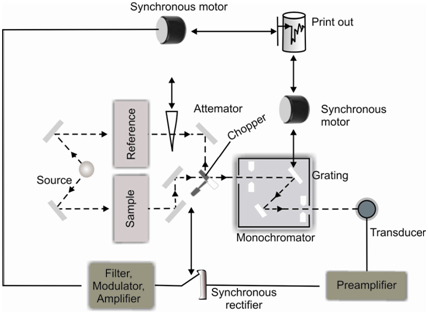Dispersive Infra Red Spectrometers:
These instruments by slightly outdated but are still employed, for qualitative work, due to economic reasons. The common set up of a dispersive IR instrument is similar to that of the double beam UV - Visible instrument. Therefore there are two differences. Firstly, a radiation emerging out of the sample cell is dispersed along with the help of a appropriate grating and not by diffraction grating as in UV-VIS spectrometers. And secondly, in IR, the sample is located among the source and the monochromator. This arrangement provides helps in getting rid of the scattered radiation from the cell compartment. The schematic diagram of the double beam dispersive instrument is given in Figure.

Figure: A schematic diagram showing different components and the optic path of a dispersive IR spectrometer
The radiation produced from an IR source is made to fall on a beam splitter which splits the beam into two equivalent half beams. These beams are focused through separate concave mirror systems on the sample and the reference (generally the solvent) cells. The beam emerging from the reference cell is made to fall on the chopper by an attenuator although the radiation from the sample is sent straight on to the chopper. The chopper alternately permits the reference beam or the sample beam to enter the monochromator. These beams after dispersion through the monochromator are made to fall on the detector. A signals originating from the detector are then suitably processed and send to the recorder for an output.